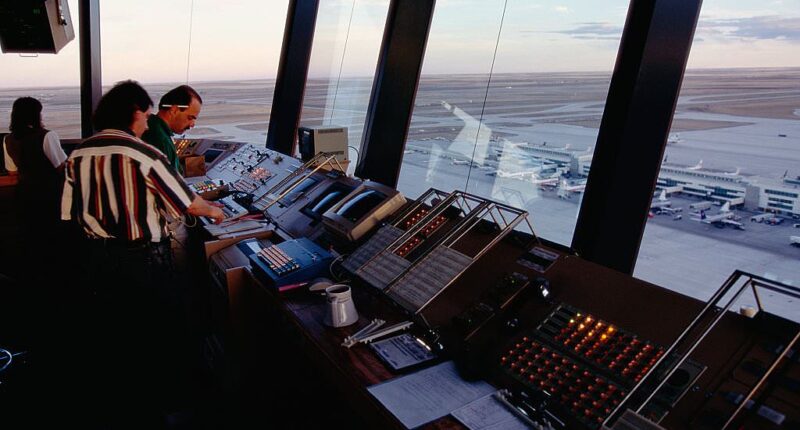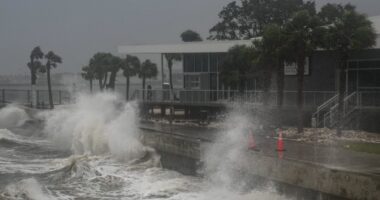For a nerve-wracking 90 seconds, the air traffic controllers handling the arrivals at Newark Liberty International Airport found themselves in a helpless situation, relying solely on hope and fear.
An unexpected glitch caused a disruption in the radar and radio communication systems on May 9, forcing controllers to deal with the crisis as planes continued their approach to one of the most bustling airports in the world.
Despite reassurances from FAA planners that such a catastrophic event was highly unlikely, the reality of the situation unfolded when a piece of malfunctioning copper wiring brought the system down during the relocation of controllers to a new facility in Philadelphia just the year before.
But an internal report leaked to DailyMail.com suggests senior officials had ample warning that the regulator’s antiquated communications system was on the brink of collapse.
The confidential document lists multiple occasions when a dozen or more tower displays failed in eerily similar circumstances across Southern California in 2022 and 2023.
A national safety panel determined the culprit was congested ethernet cabling that couldn’t cope with the volume of data traveling between radars and towers.
Ominously, the report concluded that the danger wasn’t unique to California because the FAA relies upon the same decades-old tech across the entire country.
Officials insisted that they could mitigate the ‘high risk hazard’ by installing software patches and having staffers manually monitor the signal.

Passengers were stranded on Mother’s Day after the 90-second outage grounded all flights

There was a second outage at Denver Airport on May 12
The rudimentary fix was approved by Tim Arel, the outgoing head of the FAA’s Air Traffic Organization.
But it was deemed ‘pathetic’ this week by Rick Castaldo, a retired FAA engineer, who reviewed the internal report’s findings for DailyMail.com.
‘Monitoring a failure does not stop the failure,’ Castaldo fumed.
‘It’s nearly the exact same issue that hit Newark. Those f**kers knew this was going to keep happening but they didn’t do anything about it.’
US aviation safety has been rocked by a slew of crashes and near misses in recent months, including January’s deadly midair collision between a military helicopter and an American Airlines jet in Washington, DC.
Telecoms outages at Newark on April 28 and May 9 – and a further 90-second blackout across a portion of Denver airspace on May 12 – have only added to the wave of public unease.
But less attention was paid on June 16, 2022, when controllers at 11 towers including Los Angeles International, San Diego, Ontario, Palm Springs and Long Beach suddenly found themselves staring into blank monitors.
Another 14 monitors went down simultaneously on December 26, plunging controllers at Van Nuys, El Monte, and several other small airports into a similar nightmare.
‘While some towers are able to recover automatically, some have to be reconfigured online manually,’ the report said, without revealing how long that takes.

Transportation Secretary Sean Duffy blamed the Biden administration for not dealing with the situation earlier

This leaked internal report suggests senior officials had ample warning that the regulator’s antiquated communications system was on the brink of collapse

View of debris as the Coast Guard, local, state and federal agencies respond in the aftermath of the collision of American Eagle flight 5342 and a Black Hawk helicopter that crashed into the Potomac River, near Reagan Washington National Airport
The underlying problem, the document notes, involves a key FAA processing platform named STARS (Standard Terminal Automation Replacement System).
The technology automates massive volumes of radar, weather and real-time aviation data for regional control centers known as TRACON (Terminal Radar Approach Control) sites which guide planes to and from airports.
It’s also fed via telecommunications cables to remote airport towers which lack their own direct access to radars.
The problem, the panel explains, is that STARS was engineered by defense giant Raytheon in the 1990s to generate a continual signal compatible with analog wiring.
It was never designed for modern ethernet connections which stream data in tiny digital fragments or ‘packets’.
Ethernet is faster and more efficient but the downside is that so many packets can flood the system at once that it congests the line and creates a ‘traffic jam’.
STARS responds to the hold-up by re-transmitting the same data again and again until a ‘cascade event’ overwhelms the bandwidth and blocks the feed to remote tower displays.
From August 2023, staff were told to monitor signals across the Southern California TRACON network three times a day to keep an eye out for troublesome data spikes.
They detected a further 42 signal issues but could do little to prevent 28 monitors going dead on March 3, 15 more on April 27, and a further three outages on November 14, affecting a total of 23 airports.

Outgoing FAA head Tim Arel approved software patches that have been slammed as ‘pathetic’

The confidential document lists multiple occasions when a dozen or more tower displays failed in eerily similar circumstances across Southern California in 2022 and 2023

Staff detected a further 42 signal issues but could do little to prevent 28 monitors going dead on March 3, 15 more on April 27, and a further three outages on November 14, affecting a total of 23 airports
In one instance workers tried to remedy a failing line at Hollywood Burbank Airport by manually disconnecting the network – akin to yanking an LAN cable from the back of a domestic router.
‘The duration of the communication line failure lasted six days,’ the report noted. The eventual fix was ‘untimely and cumbersome’.
It warned that similar hazards could be anticipated wherever the STARS software is operational, making it a nationwide safety risk.
Castaldo told DailyMail.com that Southern California was especially prone to outages because the vast distances between radars and towers there create greater vulnerabilities.
For that same reason, he wasn’t surprised to see similar issues afflicting Newark, a major hub for the New York City area and the nation’s 13th busiest airport.
FAA chiefs transferred control of Newark’s airspace to the Philadelphia TRACON in July 2024 to address chronic controller shortages in its former New York base and reduce congestion in the Northeast corridor.
However, the New Jersey airport’s radio and radar feeds are still being processed in Long Island and fed south in what critics have likened to a 100-mile ‘extension cord’ made of copper wiring.
According to CNN, a pre-move analysis downplayed concerns about a communications breakdown and rated the chances as one in 11 million.

Officials insisted that they could mitigate the ‘high risk hazard’ by installing software patches and having staffers manually monitor the signal
Castaldo, who worked at the FAA for more than two decades, said multiple backup systems should have been installed regardless.
‘Every airplane on the planet has built-in redundancy for the ‘oh s**t’ moments that happen when you’re flying. It costs a fortune but that’s why these machines are so reliable,’ he said.
‘It’s inexcusable that they didn’t apply that principle.’
In a Tuesday press conference Transportation Secretary Sean Duffy blasted the Biden administration for pushing ahead with the Newark move ‘without properly hardening the telecom lines feeding the data’.
‘Pete Buttigieg and Joe Biden did nothing to fix this system that they knew was broken,’ Duffy fumed, blaming his predecessor at the Department of Transportation.
‘Without addressing the underlying infrastructure, they added more risk to the system.’
Duffy has promised three new telecommunications lines between New York and Philadelphia as well as a three-year modernization program replacing aging radars and copper wiring with the latest fiber, wireless and satellite technology.
FAA insiders fear he’s been set up to fail.
‘Secretary Duffy is apparently listening to the same FAA people who have gotten us into this mess,’ a senior official told DailyMail.com.
‘Integrating a new system while maintaining 24/7 operational efficiency is like changing a flat tire on a car going 70mph on the freeway.
‘It will not be an overnight or a three to five-year solution.’

Experts weren’t surprised to see similar issues afflicting Newark, a major hub for the New York City area and the nation’s 13th busiest airport
It was revealed last month that Arel, an FAA veteran of the past four decades, will soon be stepping down after accepting President Trump’s federal ‘buyout’ plan.
However, many of the senior officials named in DailyMail.com’s confidential report remain in key FAA positions.
‘Duffy is a smart guy but he’s up against an entrenched bureaucracy that has no clue how to fix this problem. They need a fresh team in there,’ Castaldo said.
‘The last outage was at 4am. Thank God it didn’t happen in bad weather in peak hours when there are 40 to 60 planes maneuvering at 200mph.
‘I would have serious reservations about flying into Newark, period.’

















